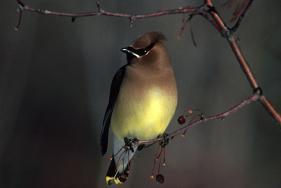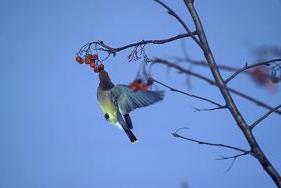
Courtesy
US FWS Digital Library
David Menke, Photographer
For the chance to admire a flock of Utah’s most rakishly handsome songbirds, look to the sky or trees when you hear this call:
[Kevin Colver, Cedar Waxwing, Songbirds of Yellowstone and the High Rockies…]
That high, thin whistle indicates waxwings. All winter long, waxwings stick together in dense, cohesive flocks that fluidly fly and forage as one. Like locusts, a flock will swarm over a mountain ash, juniper or hawthorn, quickly stripping it of the small fruits that constitute their diet. They eat a wide variety of small fruits from berries to grapes to cherries. Cedar waxwings are commonly seen throughout Utah all winter long. They are nomadic; traveling to where ever fruit is abundant. Some winters, they are joined here by their northern cousins, the Bohemian waxwings. Both waxwings are debonair, with a sweptback crest and an angular black Zorro mask. The name waxwing refers to a line of scarlet waxy droplets at the tips of specialized wing feathers. More likely you’ll notice the bar of lemon-yellow feather tips across the tail. Both of those colors come from pigments in their fruity diets. The body of the smaller Cedar waxwing is more caramel-colored than the grayer Bohemian waxwing. Bohemian waxwings have a distinct rufus patch of feathers beneath the tail.

David Menke, US FWS
FWS Digital Library
So remember to pay attention when you hear that high-pitched whistle and look around you for trees decorated with these snazzy-looking waxwings. They will surely put some zing in your drab winter day.
Thanks to Kevin Colver for the use of his bird recordings.
This is Linda Kervin for Bridgerland Audubon Society.
Credits:

Bird Recordings: Courtesy & Copyright Kevin Colver, Cedar Waxwing, Songbirds of Yellowstone and the High Rockies… //wildaboututah.org/about-us/#7loons
Pictures: David Menke, US FWS Digital Library
Courtesy & Copyright 2006 Stephen Peterson
Text: Jim Cane, Bridgerland Audubon Society
Additional Reading:

Creating Landscapes for Wildlife …A Guide to Backyard Gardens in Utah, https://digitallibrary.utah.gov/awweb/awarchive?type=file&item=10215
